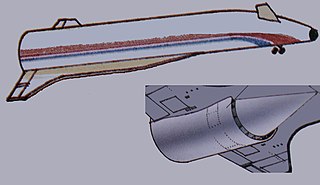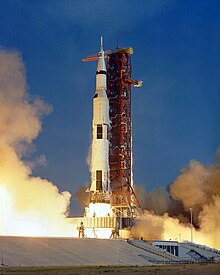
HOTOL, for Horizontal Take-Off and Landing, was a 1980s British design for a single-stage-to-orbit (SSTO) spaceplane that was to be powered by an airbreathing jet engine. Development was being conducted by a consortium led by Rolls-Royce and British Aerospace (BAe).

A single-stage-to-orbit (SSTO) vehicle reaches orbit from the surface of a body using only propellants and fluids and without expending tanks, engines, or other major hardware. The term usually, but not exclusively, refers to reusable vehicles. To date, no Earth-launched SSTO launch vehicles have ever been flown; orbital launches from Earth have been performed by either fully or partially expendable multi-stage rockets.

A spacecraft is a vehicle that is designed to fly in outer space and operate there. Spacecraft are used for a variety of purposes, including communications, Earth observation, meteorology, navigation, space colonization, planetary exploration, and transportation of humans and cargo. All spacecraft except single-stage-to-orbit vehicles cannot get into space on their own, and require a launch vehicle.
Payload is the object or the entity which is being carried by an aircraft or launch vehicle. Sometimes payload also refers to the carrying capacity of an aircraft or launch vehicle, usually measured in terms of weight. Depending on the nature of the flight or mission, the payload of a vehicle may include cargo, passengers, flight crew, munitions, scientific instruments or experiments, or other equipment. Extra fuel, when optionally carried, is also considered part of the payload.

An expendable launch system is a launch vehicle that can be launched only once, after which its components are either destroyed during reentry or discarded in space. ELVs typically consist of several rocket stages that are discarded sequentially as their fuel is exhausted and the vehicle gains altitude and speed. As of 2022, most satellites and human spacecraft are currently launched on ELVs. ELVs are simpler in design than reusable launch systems and therefore may have a lower production cost. Furthermore, an ELV can use its entire fuel supply to accelerate its payload, offering greater payloads. ELVs are proven technology in widespread use for many decades.
A tripropellant rocket is a rocket that uses three propellants, as opposed to the more common bipropellant rocket or monopropellant rocket designs, which use two or one propellants, respectively. Tripropellant systems can be designed to have high specific impulse and have been investigated for single-stage-to-orbit designs. While tripropellant engines have been tested by Rocketdyne and Energomash, no tripropellant rocket has been flown.

Spaceflight is an application of astronautics to fly objects, usually spacecraft, into or through outer space, either with or without humans on board. Most spaceflight is uncrewed and conducted mainly with spacecraft such as satellites in orbit around Earth, but also includes space probes for flights beyond Earth orbit. Such spaceflight operate either by telerobotic or autonomous control. The more complex human spaceflight has been pursued soon after the first orbital satellites and has reached the Moon and permanent human presence in space around Earth, particularly with the use of space stations. Human spaceflight programs include the Soyuz, Shenzhou, the past Apollo Moon landing and the Space Shuttle programs. Other current spaceflight are conducted to the International Space Station and to China's Tiangong Space Station.

The Automated Transfer Vehicle, originally Ariane Transfer Vehicle or ATV, was an expendable cargo spacecraft developed by the European Space Agency (ESA), used for space cargo transport in 2008–2015. The ATV design was launched to orbit five times, exclusively by the Ariane 5 heavy-lift launch vehicle. It effectively was a larger European counterpart to the Russian Progress cargo spacecraft for carrying upmass to a single destination—the International Space Station (ISS)—but with three times the capacity.
In aerospace engineering, the propellant mass fraction is the portion of a vehicle's mass which does not reach the destination, usually used as a measure of the vehicle's performance. In other words, the propellant mass fraction is the ratio between the propellant mass and the initial mass of the vehicle. In a spacecraft, the destination is usually an orbit, while for aircraft it is their landing location. A higher mass fraction represents less weight in a design. Another related measure is the payload fraction, which is the fraction of initial weight that is payload. It can be applied to a vehicle, a stage of a vehicle or to a rocket propulsion system.

A reusable launch vehicle has parts that can be recovered and reflown, while carrying payloads from the surface to outer space. Rocket stages are the most common launch vehicle parts aimed for reuse. Smaller parts such as rocket engines and boosters can also be reused, though reusable spacecraft may be launched on top of an expendable launch vehicle. Reusable launch vehicles do not need to make these parts for each launch, therefore reducing its launch cost significantly. However, these benefits are diminished by the cost of recovery and refurbishment.

A spaceplane is a vehicle that can fly and glide like an aircraft in Earth's atmosphere and maneuver like a spacecraft in outer space. To do so, spaceplanes must incorporate features of both aircraft and spacecraft. Orbital spaceplanes tend to be more similar to conventional spacecraft, while sub-orbital spaceplanes tend to be more similar to fixed-wing aircraft. All spaceplanes to date have been rocket-powered for takeoff and climb, but have then landed as unpowered gliders.

A two-stage-to-orbit (TSTO) or two-stage rocket is a launch vehicle in which two distinct stages provide propulsion consecutively in order to achieve orbital velocity. It is intermediate between a three-stage-to-orbit launcher and a hypothetical single-stage-to-orbit (SSTO) launcher.

Skylon is a series of concept designs for a reusable single-stage-to-orbit spaceplane by the British company Reaction Engines Limited (Reaction), using SABRE, a combined-cycle, air-breathing rocket propulsion system.

A launch vehicle is typically a rocket-powered vehicle designed to carry a payload from Earth's surface or lower atmosphere to outer space. The most common form is the ballistic missile-shaped multistage rocket, but the term is more general and also encompasses vehicles like the Space Shuttle. Most launch vehicles operate from a launch pad, supported by a launch control center and systems such as vehicle assembly and fueling. Launch vehicles are engineered with advanced aerodynamics and technologies, which contribute to high operating costs.

Reaction Engines Limited is a British aerospace manufacturer based in Oxfordshire, England.

An orbital propellant depot is a cache of propellant that is placed in orbit around Earth or another body to allow spacecraft or the transfer stage of the spacecraft to be fueled in space. It is one of the types of space resource depots that have been proposed for enabling infrastructure-based space exploration. Many different depot concepts exist depending on the type of fuel to be supplied, location, or type of depot which may also include a propellant tanker that delivers a single load to a spacecraft at a specified orbital location and then departs. In-space fuel depots are not necessarily located near or at a space station.

A rocket sled launch, also known as ground-based launch assist, catapult launch assist, and sky-ramp launch, is a proposed method for launching space vehicles. With this concept the launch vehicle is supported by an eastward pointing rail or maglev track that goes up the side of a mountain while an externally applied force is used to accelerate the launch vehicle to a given velocity. Using an externally applied force for the initial acceleration reduces the propellant the launch vehicle needs to carry to reach orbit. This allows the launch vehicle to carry a larger payload and reduces the cost of getting to orbit. When the amount of velocity added to the launch vehicle by the ground accelerator becomes great enough, single-stage-to-orbit flight with a reusable launch vehicle becomes possible.
Aircraft can have different ways to take off and land. Conventional airplanes accelerate along the ground until sufficient lift is generated for takeoff, and reverse the process to land. Some airplanes can take off at low speed, this being a short takeoff. Some aircraft such as helicopters and Harrier jump jets can take off and land vertically. Rockets also usually take off vertically, but some designs can land horizontally.

A super heavy-lift launch vehicle is a rocket that can lift to low Earth orbit a "super heavy payload", which is defined as more than 50 metric tons (110,000 lb) by the United States and as more than 100 metric tons (220,000 lb) by Russia. It is the most capable launch vehicle classification by mass to orbit, exceeding that of the heavy-lift launch vehicle classification.
TGK PG is an automated cargo spacecraft project to replace Progress-MS as the Russian logistic vehicle to the ISS. It was requested for development to take advantage of the increased lift capacity of the Soyuz-2.1b. The initial development contract was awarded to RSC Energia by Roscosmos on December 11, 2015. The spacecraft is not expected to fly before 2020.















